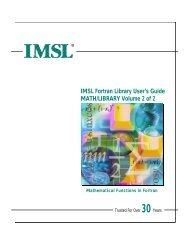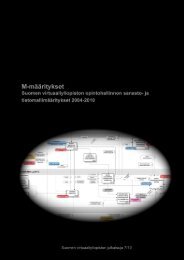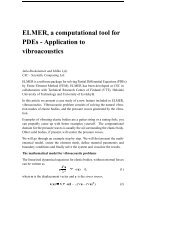Application of 2D-NMR spectroscopy to metabolomics and ... - CSC
Application of 2D-NMR spectroscopy to metabolomics and ... - CSC
Application of 2D-NMR spectroscopy to metabolomics and ... - CSC
Create successful ePaper yourself
Turn your PDF publications into a flip-book with our unique Google optimized e-Paper software.
<strong>Application</strong> <strong>of</strong> <strong>2D</strong>-<strong>NMR</strong> <strong>spectroscopy</strong><strong>to</strong> <strong>metabolomics</strong> <strong>and</strong> identification <strong>of</strong> metabolitesNovember 10 – 14, 2008Young Hae ChoiDivision <strong>of</strong> Pharmacognosy, Section MetabolomicsInstitute <strong>of</strong> Biology, Leiden UniversityLeiden, Then Netherl<strong>and</strong>s
Structure elucidation <strong>of</strong> metabolites in the mixture- Using diverse <strong>spectroscopy</strong>• You have knowledge about metabolites• You’ve prepared samples for analysis• You’ve collected data using analytical methods• You’ve selected interesting <strong>and</strong> significant signalsThen, what is the next step?
How can we elucidate the selected metabolites?0.20.1?w*c[2]-0.0-0.1-0.2-0.10 -0.05 -0.00 0.05 0.10w*c[1]
Advantages <strong>of</strong> <strong>NMR</strong> in Metabolomics• Simultaneous observation <strong>of</strong> wide range <strong>of</strong> chemical classes(Mole based detection, non-selective)• Powerful structural elucidation <strong>to</strong>ol• Non-destructive method• High throughput (no sample preparation)• Measures molecular interaction <strong>and</strong> concentration• Easy <strong>to</strong> obtain digitized data for statistical analysis• Independent on instruments (the same results from any apparatus)
Example : Identification <strong>of</strong> Differentiating MetabolitesGeneral procedure1H-<strong>NMR</strong> analysisData processingMultivariate data analysisSignal sorting<strong>2D</strong>-<strong>NMR</strong> measurements 1Fractionation (if necessary) 2Structure elucidation<strong>2D</strong>-<strong>NMR</strong> measurements 1J-resolvedCOSY, TOCSY, LR-COSYHSQC (HMQC)HMBC, HSQC-TOCSYFractionation (chroma<strong>to</strong>graphy) 2HP-20, Sephadex LH-20, C18,Centrifugal partition chroma<strong>to</strong>graphyQuantitative <strong>NMR</strong> for target metabolites
If you find interesting signal using multivariate data analysisPC30 .2 00 .1 00 .0 0-0 .1 0?-0 .2 0-0 .3 02 0 4 0 6 0 8 0 1 0 0 1 2 0 1 4 0 1 6 0 1 8 0 2 0 0 2 2 0Return <strong>to</strong>original spectrumLoading plot (δ 0 – δ 10.0)1H-<strong>NMR</strong> spectrumControlLocal-infected?1H-<strong>NMR</strong> (δ 6.0 – δ 6.8)
Two dimensional (<strong>2D</strong>)-<strong>NMR</strong>• 1D-<strong>NMR</strong> : Chemical shift <strong>and</strong> its intensity• <strong>2D</strong>-<strong>NMR</strong> : Chemical shift, other variables ( 13 C-chemical shift, or correlation),<strong>and</strong> its intesity<strong>2D</strong>Chemical shift <strong>of</strong> 13 C-<strong>NMR</strong>1DChemical shift <strong>of</strong> 1 H-<strong>NMR</strong>Chemical shift <strong>of</strong> 1 H-<strong>NMR</strong>
COSY, TOCSY, HSQC, HMBC• 1 H-<strong>NMR</strong> :basic identification, fingerprinting,further statistical analysis• 13 C-<strong>NMR</strong> :second identification for quaternary carbon(e. g. carbonyl group)• COSY, TOCSY :elucidation <strong>of</strong> carbohydrates <strong>and</strong> organicacids, amino acids• HSQC :confirmation <strong>of</strong> 1 H-<strong>NMR</strong> elucidation,further statistical analysis for complex plantextract• HMBC :confirmation <strong>of</strong> 1 H-<strong>NMR</strong> elucidation,elucidation <strong>of</strong> glycosides• NOESY :spatial correlation(stereo chemistry <strong>of</strong> metabolites)
1H-<strong>NMR</strong>: all information therein<strong>NMR</strong> always wants <strong>to</strong> give a lot <strong>of</strong> information for compounds! But it’s up <strong>to</strong> you?
First approachUsing Chemical Shift in 1 H-<strong>NMR</strong>
1H-<strong>NMR</strong> for the Mixture <strong>of</strong> Tobacco2'3NNHNCH 3N
Flavonoids, Phenylpropanoids, Aromatic amino acids, Simple phenolics …
Carbohydrates, Amino acids, Terpenes, Organic acids …
Organic acids, Amino acids, Terpenes …
Methyl <strong>of</strong> Terpenes (δ 0.5 – δ 2.0)
Database?• ACD, Chenomx, Biorad (KnowItall), AMIX…• But lack <strong>of</strong> plant secondary metabolites• In-hose database
1H-<strong>NMR</strong> spectrum <strong>of</strong> glucoseβ−Η1α−Η1Monosaccharide has two forms in water solution
1H-<strong>NMR</strong> spectrum <strong>of</strong> rhamnoseβ−Η6HOHOHH 3 CHOHOHOHα−Η6Hα−Η1β−Η1
Differentiation <strong>of</strong> DiasteromersR 1 OOHR 2OHH-2 <strong>of</strong> R- <strong>and</strong> S-formOHOR <strong>and</strong> S forms
1H-<strong>NMR</strong> spectrum <strong>of</strong> secologaninH-3H-3H-3H-3 has 1-3 signals depending pH (one signal in strong acid condition)
Second approachUsing J-resolved for splitting pattern
How many signals do you need for elucidation?It depends on structuresAt least 7 phenylpropanoidsAt least 3 flavonoidsDimeric phenylpropanoids
1H-<strong>NMR</strong> spectrum <strong>of</strong> ursolic acidMethyl signals are characteristics for terpenoids in <strong>NMR</strong>
<strong>2D</strong> J-Resolved : phenylpropanoid <strong>and</strong> flavonoidRRRCOORphenylpropanboidsRRRRRflavonoidsBrassica rapa leaves
<strong>2D</strong> J-Resolved :terpenoidHO18OH641619111151720Nicotiana tabacum leaves
COSYH-2’H-6’ H-5’ H-8 H-63Vitis vinifera leaves
Total Correlated Spectroscopy (TOCSY)• Useful for amino acids <strong>and</strong> carbohydrates identification
TOCSY
TOCSYMixing time is important : low mixing time resultsin less correlations (the same <strong>to</strong> COSY)50 ms 80 ms
HSQC (or HMQC) for target 13 C signalGenista tenera leaves
HMBC: a wealth <strong>of</strong> information
Flavonoids from Genista tenera : HMBCH-1”, C-8H-1”, C-7H-1”, C-8aH-1”, C-7
<strong>Application</strong> <strong>of</strong> HSQC-TOCSY <strong>to</strong> <strong>metabolomics</strong>• Indirectly, the information <strong>of</strong> 13 C chemical shift can be obtainedusing combined <strong>2D</strong>-<strong>NMR</strong> (e.g. HSQC-TOCSY)1: malic acid2: aspartic acid1 12222112 2Nicotiana plumbaginifolia cell lines
Structure Confirmation by Mass Spectrometry295.0325.0200 250 300 350 400 450 500 m/z279.1339.1200 250 300 350 400 450 500 m/z309.1200 250 300 350 400 450 500 m/z
<strong>Application</strong> <strong>of</strong> SPE for flavonoids in Arabidopsis thalianaTotal extractSephadex LH-20 fractiontyrosinefumaric acid1H-<strong>NMR</strong> (δ 5.0 – δ 8.5)1H-<strong>NMR</strong> (δ 5.0 – δ 8.5)Sinapoyl malate1H-<strong>NMR</strong> (δ 5.0 – δ 8.5)flavonoidsR 1= Glc, Rha, or Glc-GlcR 2= H, OH1H-<strong>NMR</strong> (δ 5.0 – δ 8.5)
Complex Spectra: - Projection <strong>of</strong> J-resolved Spectra -1H-<strong>NMR</strong><strong>2D</strong>-J-resolvedProjection <strong>of</strong> J-resolved• Less complex spectra• Decoupled spectra like 13 C• Higher resolution• Better separation in further PCA
From a ‘Metabolomids’ <strong>to</strong> a real ‘System Biologist’Elucidation <strong>of</strong> MetabolitesSnapshotFunction <strong>of</strong> MetabolitesFilmMetabolomics can just open chemical world <strong>of</strong> living organisms-First step <strong>to</strong> confirm chemical changesBut there is still something missing-When or where (Time <strong>and</strong> Space)Fluxomics?
Thanks <strong>to</strong>• Dr. Hye Kyong Kim: for Data Processing• Dr. Federica Maltese: for flavonids work• Mr. Ibrahim Abdelfreed El-Bayoumi: for Brassica spectra• Mr. Muhammad Jahangir: for Brassica spectra• Ms. Sanimah Simoh: for Brassica spectra• Dr. Alex<strong>and</strong>re T. Cardoso Taketa: for Galphimia glauca work- Universidad Autónoma del Estado de Morelos, Morelos, Mexico









